








The Barracuda: Sphyraena barracuda
Sphyraena barracuda, the barracuda, is a long, slender and predaceaous marine fish with small scales, a large mouth with fanglike teeth, and a protruding lower jaw. The tail fin is forked, and the two dorsal fins are widely separated. Barracuda are found in tropical and subtropical waters of the Atlantic, Indian, and Pacific oceans. Smaller species swim in schools, but larger species are solitary. This is the famous Smokey the Barracuda, seen on the cover of skin diver magazine many times. Smokey used to circle us counterclockwise and we would feed him by sticking fish in our mouth which he would snatch out very quickly, with no harm to us.

Print Number - TF002
Limited Edition signed color photography for sale by Stephen Brunson
Baraccuda Statistics:
Size: Up to 6' in Length
Lifespan: Estimated up to 14 years
Number of Young: Unknown
Mating Season: April - May
Diet: Fishes, shrimp, and occasionally squid
Distribution: From Massachusetts to Southern Brazil, including Bermuda, the Gulf of Mexico, the Caribbean, and Antilles
Habit: Small ones in schools; larger Barracuda are usually solitary.
Danger to humans:
Although barracuda attacks on humans are rare, they are feared by swimmers in some places,
due to its speed, agility, and long teeth. The great barracuda can swim up to 35 mph, yet it
can move forward slowly with no apparent effort; thus increasing its stealth.
BrunsonImages@att.net


















